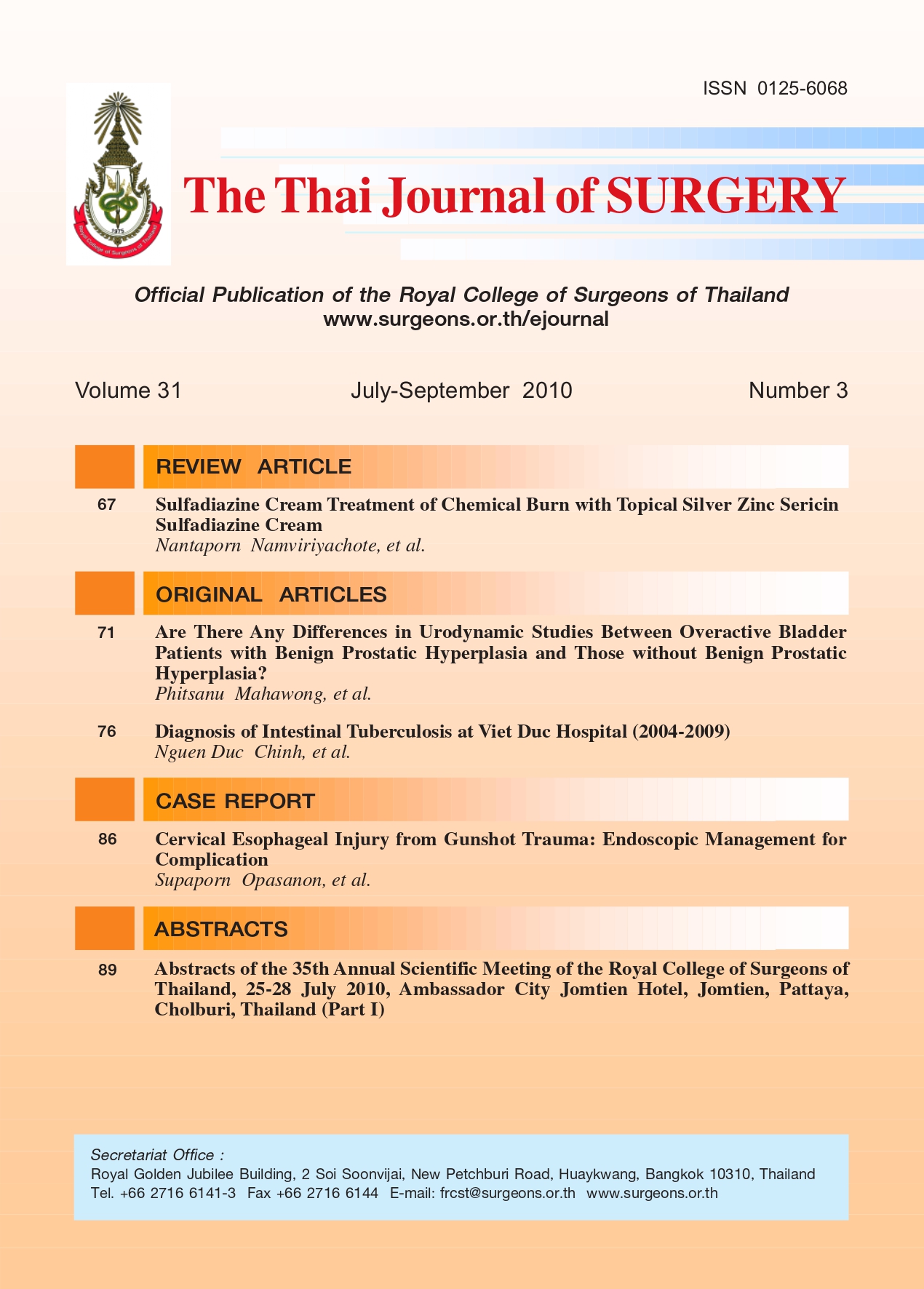Are There Any Differences in Urodynamic Studies Between Overactive Bladder Patients with Benign Prostatic Hyperplasia and Those without Benign Prostatic Hyperplasia?
Abstract
Introduction: Overactive bladder and benign prostatic hyperplasia are quite common in middle agemen. Some patients may have both of these conditions in the same time. Urodynamic study is still the most
useful diagnostic test in this group of the patients because their lower urinary tract symptoms are unreliable.
Objective: To compare results of urodynamic studies between overactive bladder patients with benign
prostatic hyperplasia and overactive bladder patients without benign prostatic hyperplasia.
Materials and Methods: From November 2007 to October 2009, 75 urodynamic studies were performed
for male overactive bladder patients who were 40 years or older. The patients were retrospectively divided into
two groups. Group I consisted of overactive bladder patients who also had been clinically diagnosed with benign
prostatic hyperplasia, and Group II consisted of overactive bladder patients without benign prostatic hyperplasia.
There were 41 patients in group I and 34 patients in group II. The results of the two groups were analyzed and
compared.
Results: There was a statistical difference only in terms of median post-void residual urine volume.
Detrusor overactivities were demonstrated in 21/41(51.2%) patients of Group I and in 19/34 (55.9%) patients
of Group II (P-value = 0.687). Nine patients in Group I (9/41; 21.9%) and eight patients in Group II (8/34;
23.5%) represented bladder outlet obstruction (P-value = 0.871). Impaired detrusor contractilities were found
in only five patients of Group I (P = 0.060).
Conclusions: The urodynamic results indicate that only the median post-void residual urine volume was
statistically different between two groups of patients.
References
survey of urinary incontinence, overactive bladder, and
other lower urinary tract symptoms in five countries: results of
the EPIC study. Eur Urol 2006; 50:1306-14.
2. Moorthy P, Lapitan MC, Quek PL, et al. Prevalence of
overactive bladder in Asian men: an epidermiological survey.
BJU Int 2004;93:528-31.
3. Abram P, Cardozo L, Fall M, et al. The standardization of
terminology in lower urinary tract function: report from the
standardization sub-committee of the International
Continence Society. Urology 2003;61:37-49.
4. Blaivas JG, Mark BK, Weiss JP, Panaqopoulos G, Somaroo C.
Differential diagnosis of overactive bladder in men. J Urol
2009;182:2814-7.
5. Safarinejad MR. Prevalence of benign prostatic hyperplasia
in a population-based study in Iranian men 40 years old or
older. Int Urol Nephrol 2008;40:921-31.
6. Schafer W, Abrams P, Liao L, et al. Good urodynamic
practices: uroflowmetry, filling cystometry, and pressureflow
studies. Neurourol Urodyn 2002;21:261-74.
7. Toppercer A, Tetreault JP.Compliance of the bladder: an
attempt to establish normal values. Urology 1779;14:204-5.
8. Griffiths D, Hofner K, van Mastrigt R, et al. Standardization of
terminology of lower urinary tract function: pressure-flow
studies of voiding, urethral resistance, and urethral
obstruction. International Continence Society
Subcommittee on Standardization of Terminology of
Pressure-Flow Studies. Neurourol Urodyn 1997;16:1-18.
9. Abarbnel J, Marcus EL. Impaired detrusor contractility in
community-dwelling elderly presenting with lower tract
symptoms. Urology 2007;69:436-40.
10. Abrams P. LUTS, BPH, BPE, BPO: A plea for the logical use of
correct terms. Rev Urol 1999;1:65.
11. Irwin DE, Milson I, Kopp Z, Abrams P, Artibani W, Herschon S.
Prevalence, severity, and symptom bother of lower urinary
tract symptoms among men in the EPIC study: impact of
overactive bladder. Eur Urol 2009;56:14-20.
12. Smith PP. Aging and the underactive detrusor: a failure of
activity or activation. Neurourol Urodyn 2010;29:408-12.
13. Taylor JA 3rd, Kuchel GA. Detrusor underactivity: clinical
features and pathogenesis of an underdiagnoed geriatric
condition. J Am Geriatr Soc 2006;54:1920-32.
14. Hofner K, Burkart M, Jacob G, Jonas U. Symptomatic and
quality of life response to tolterodine in subgroups of men
with overactive bladder symptoms and presumed nonobstructive
benign prostatic hyperplasia. World J Urol
2010;28:353-7.
15. Anderson KE. LUTS treatment: future treatment options.
Neurourol Urodyn 2007;26:934-47.
16. Mahawong P, Chaiyaprasithi B, Soontapa S, Tappayutapijarn
P. A role of intravesical capsaicin instillation in benign
prostaic hyperplasia with overactive bladder: the first
reported in the literature. J Med Assoc Thai 2007;90:1821-7.
Downloads
Published
How to Cite
Issue
Section
License
Articles must be contributed solely to The Thai Journal of Surgery and when published become the property of the Royal College of Surgeons of Thailand. The Royal College of Surgeons of Thailand reserves copyright on all published materials and such materials may not be reproduced in any form without the written permission.


